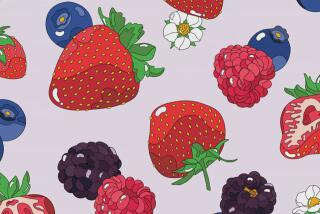Superfruit, or just a plain old Clark Kent fruit?
It’s expensive! It’s exotic! It’s superfruit!
Meaning what, exactly?
The term “superfruit” has been applied to acai berries, maqui berries, yumberries, chokeberries, goji berries, lingonberries, lychee berries — a lot of berries, in other words, but also baobabs, mangosteens, sea buckthorn, jujube fruit, cupuacus, pitayas, pomegranates ... the list keeps growing.
You may wonder what is it about these fruits that lifts them out of the ranks of the ordinary into exalted superfruit status.
SuperPR, that’s what.
“‘Superfruit’ is just a marketing term,” says Gregory Cole, a professor of medicine and neurology at UCLA and associate director of research at the Greater Los Angeles Veterans Affairs Geriatrics Center. Still, if it conjures up the notion of fruits that have super powers for making you healthy, the marketers who introduced it in 2005 would not be disappointed.
Those who believe in superfruit super powers generally say they come, in large part at least, from the antioxidants the superfruits contain. Claims of nutritional glories vary from superfruit to superfruit, but high antioxidant content is generally on the list, most likely at the top.
The logic seems simple enough: Antioxidants are good for you. Superfruits have more antioxidants than your average fruit. Therefore, superfruits are very good — super good — for you.
That conclusion requires a small leap of faith, namely, that if some antioxidants are good, more must be better. It’s not a leap that everyone is willing to make. We just don’t know enough, Cole says. There may be a limit to how many antioxidants your body can absorb. Or maybe your body can absorb them all, but after a point, they don’t do you any more good —- may even do you harm.
A case in point: A series of recent studies at Kansas State University found that a super-abundance of antioxidants can actually interfere with proper muscle function.
Besides, fruits are more than just tasty antioxidant delivery systems. “They have a lot of different compounds with interesting medicinal properties,” Cole says. “But plants also make pesticides and anti-microbial compounds that may have toxic properties.” Raw almonds are full of cyanide, and so are cherry pits and apple seeds, just to name a few disconcerting examples.
Researcher Barbara Hale is more supportive than Cole of the concept of superfruits, or “high polyphenolic fruits,” as she terms them. (This may explain why she’s a scientist at the Agriculture Department’s Human Nutrition Research Center on Aging at Tufts University instead of an advertising copywriter).
Still, she agrees that antioxidants don’t tell the whole story. The antioxidant properties in superfruits come from their polyphenols, substances that give the fruits their color. But some polyphenols also have anti-inflammatory properties, and Hale believes these may be just as important as their antioxidant capacities.
Blueberries garnered the first superfruit title after they were included in a bestselling book about 14 “superfoods” that could “change your life.” In short order, blueberries became quite possibly the most studied fruit in the world, and claims began to mount that they could keep you young, make you smart and cure just about anything that ailed you — or better yet, stop you from getting sick in the first place.
(In the rush to jump on the bandwagon, rules of logic weren’t always strictly enforced. For example, some concluded that blueberries improve night vision because bilberry extracts do, and blueberries and bilberries are cousins.)
Interestingly, blueberries may be contenders for superfruit of the year again in 2012. But not the good old blueberries you can find at the store. In a study published last year, researchers reported on two species of wild blueberries native to Central and South America that they’re calling “extreme superfruits” because they have two to four times more antioxidants than the lowly has-beens you’re used to.
For the most part, the superfruit designation has gone to fruits that are unusual, and unusually pricey — qualities that, along with hard-to-pronounce names, can impart a certain cachet. (To become the pick of the superfruit crop, the extreme blueberries may need to go by their scientific names, Cavendishia grandifolia and Anthopterus wardii.)
Even among skeptics, there’s widespread agreement that most superfruits are probably good for you — though maybe not especially so. “Small trials may show that the upper-class fruits are better than placebos,” Cole says, “but are they better than the common fruits?” That’s a hard question to answer, because the little-nobody fruits are often less likely than the high-end crowd to get research attention — and dollars.
“We can’t say anything about fruits we haven’t studied,” Hale says. “Who knows? Maybe the peach is the best thing out there. We don’t know, because we haven’t studied the peach.”
More to Read
Eat your way across L.A.
Get our weekly Tasting Notes newsletter for reviews, news and more.
You may occasionally receive promotional content from the Los Angeles Times.










